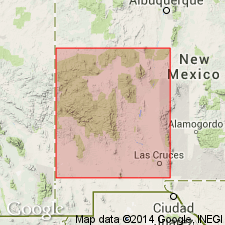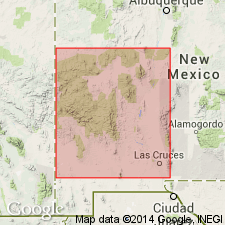
- Usage in publication:
-
- South Canyon Tuff
- Modifications:
-
- Overview
- Geochronologic dating
Summary:
Location of type section described as at mouth of South Canyon, approximately 12 mi southwest of Socorro on northwest side of mouth in SW1/4 sec 30, T3S, R2W, Socorro Co., NM in the Orogrande basin. Is present throughout northeast Mogollon-Datil volcanic field except for Datil area, northern Gallinas Mountains, and Bear Mountains. Replaces term Potato Canyon Rhyolite Tuff (abandoned). Composed of rhyolite ash-flow tuffs that are crystal poor to moderately crystal rich, thick, and continuous. Is a simple to compound cooling unit that is a quartz-rich, one-feldspar rhyolite tuff. Totals up to 650 ft thick. Is younger than La Jara Peak Basaltic Andesite and older than Santa Fe Group. Assigned to Oligocene. A 26.7 m.y. average obtained from two K-Ar dates on biotite. Source unknown.
Source: GNU records (USGS DDS-6; Denver GNULEX).

- Usage in publication:
-
- South Canyon Tuff
- Modifications:
-
- Geochronologic dating
- Paleomagnetics
- AAPG geologic province:
-
- Basin-and-Range province
Summary:
Is the youngest major widespread ignimbrite in the northeast part of the Mogollon-Datil volcanic field of southwest NM in the Basin-and-Range province. Is part of Episode 3 which has an assigned age range of 29.0 to 27.4 Ma. Erupted from the Mt. Withington cauldron. Has an outflow and an intracauldron facies. Samples from both facies yields 40 Ar/ 39 Ar plateau ages of 27.28 to 27.40 Ma. Correlation chart. Has Reverse paleomagnetic remanence. Sampling of the thick intracauldron facies was not as effective as the outflow facies.
Source: GNU records (USGS DDS-6; Denver GNULEX).
For more information, please contact Nancy Stamm, Geologic Names Committee Secretary.
Asterisk (*) indicates published by U.S. Geological Survey authors.
"No current usage" (†) implies that a name has been abandoned or has fallen into disuse. Former usage and, if known, replacement name given in parentheses ( ).
Slash (/) indicates name conflicts with nomenclatural guidelines (CSN, 1933; ACSN, 1961, 1970; NACSN, 1983, 2005, 2021). May be explained within brackets ([ ]).

